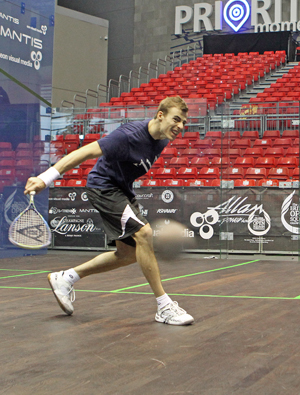
By Richard Millman, Owner – The Squash Doctor Corporation
The way that Squash is frequently learned is to first strike the ball. Unfortunately this tends to lead to a mechanically inefficient method of power transfer that, for some players, results in a lifelong failure to properly transfer, focus and manipulate their power.
In every ball sport there are numerous world class exponents who exhibit amazing timing. With apparently little or no effort on their part, they seem able to impart power so effectively that it almost seems magical.
Some of these people are just phenomenal human specimens whose minds, bodies and emotions are so synchronized that they are able to execute complex skills with ease.
But some have had to work out how to do this through methodical and relentless repetition—and with very good advice.
Where Squash is concerned, power and touch are opposite ends of the same scale. Both of these happen as a result of the efficient channeling of energy through a precisely ordered mechanical sequence that gradually funnels some proportion of the player’s body weight as a wave of energy until it’s released through the racquet face into the ball.
This is exactly the same process as we are all familiar with when, as a youth and in high spirits, we discovered that we could snap a towel or a tie and sting our team/ classmates’ legs. Where did that power come from? It came from the conversion of some proportion of our body weight into a wave of energy that was concentrated in a tiny surface area in the end of the towel or tie and produced a certain amount of pain in our friend’s leg. If you remember, the amount of power/pain was increased if you moved away as you snapped the towel/tie. This movement away produced a longer wave length and allowed the body weight/energy transfer to accelerate farther before becoming concentrated in the end of the towel/tie.
In Squash, I call this Slingshot Mechanics. In exactly the same way as a Slingshot generates enough force to send a stone on its way, skilled use of Slingshot mechanics and an intimate understanding of how to use the legs to generate a wavelength of power to channel energy through a precise point on the racquet face, will produce efficient and precisely “direct-able” energy that can be used for all shots—from the most delicate to the most powerful.
Contiguously, the movement of the legs that produces this highly efficient and valuable power source will also result in the exponent being well on their way into position for the next stage of the rally, before the ball gets to wherever the opponent intercepts it.
Timing is not magic. Even if a player has tremendous athletic ability, timing is not necessarily guaranteed unless the player intimately knows the racquet face and, prior to attempting a shot, knows precisely which exact quarter of a square inch area of string that they will release their wavelength of energy through is and when that contact will occur.
To clarify: to hit a brilliant Squash shot of any and all powers, you must understand the Slingshot mechanics concept and use your legs to begin the wave of energy that will travel through and benefit from your core. You must have wonderful stability, flexibility and relaxation to properly support and direct that energy so that it doesn’t become diffused and dissipated on its progressive journey through your body, along your arm, into your hand and fingertips and finally through a very specific part of your racquet at precisely the correct moment—to transfer into the ball. All this must happen seamlessly while you are also on your way into position to cover all of your opponent’s next shot possibilities. It is essential to keep your balance (your head and upper body) leaning toward the ball even as you are moving away, otherwise your power will be directed away from the ball in the direction you are leaning.
Standing still/static negates and opposes this process. Learning to hit a Squash shot from a stationary position actually starts the energy wave at the wrong end of the body and much of the weight transfer is shot down into the legs resulting in the player becoming even more static. This is an excellent way to develop overuse injuries as the arm attempts to take responsibility for imparting power and becomes more and more stressed as it struggles vainly to produce the energy from the power wave produced that dynamic legs supply so easily. Additionally, players who try to generate with the arm tend to tense the arm muscles in their heroic efforts to hit the ball, thereby reducing their ability to transfer power and to ‘feel’ with any precision. The arms hands and, particularly, fingers must be relaxed to be precise. Tension just blurs the sensitivity.
In case you are confused as to how you can transfer power into a shot while moving away from the ball, have a talented squash playing friend of yours snap a damp towel into your leg while they are (a) moving forward, (b) standing still and (c) as they are backing away from you. Let me know how that works out for you…


